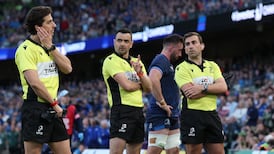On Sunday June 3rd, 1917, a desperate young woman arrived at Ailesbury Road, Dublin, from a Dorset Street tenement. For months, carefully concealing her identity, Mary Connolly had walked around the city while busking for pennies. Her mysterious comings and goings – head and shoulders shrouded by a thick, black shawl – had fascinated onlookers. Families spilled from tenements to go after her; crowds gathered at street corners to be entertained; passengers hopped from trams to join in.
As one such crowd passed down Northumberland Road, the theatre critic and diarist Joseph Holloway was "thrilled to the heart's core" by the "brilliant, electric" voice drifting through his study window. At Ballsbridge, guests left a soiree to be serenaded on the grand granite steps of a mansion. In Rathmines, JJ Ryce, a Feis Ceoil classical music judge en route to Rathgar to hear a singing candidate, jumped from a cab to go after the most natural mezzo-soprano he had ever heard.
In Ranelagh Dr Edward Parker, a hospital registrar, hurried outside to catch her, as he wanted her to audition for Dr Vincent O'Brien, director of Dublin's Palestrina Choir. (O'Brien would later become the first music director of Radio Éireann, and also tutored Count John McCormack, Italy's favourite operatic diva Margaret Burke Sheridan and James Joyce).
Entrapment
Connolly’s rebuff to Parker was courteous, but firm: pre-empting men’s advances was vital. With scores of prostitutes on the streets, police entrapment – for begging “or worse” – was a terrifying threat.
Significantly, it was a woman who got through her defences to lift 24-year-old Mary Connolly to stardom. AE Stewart was hosting an “at home” in 40 Ailesbury Road as Connolly walked past. As Stewart’s guests moved outside, rumours buzzed: she was a professional soprano down on her luck; an opera star completing a bet; a Belgian refugee. Stewart brought her in, and a barely credible account of a life blighted by tragedy emerged.
Stewart forwarded Connolly’s story to a popular music columnist and papers everywhere copied it, happy to name the anonymous singer many had heard of.
Dublin's bankrupt Empire Theatre (now the Olympia) moved quickly to sign her. Over two weeks it sold 64,000 tickets at 28 concerts, breaking box office records and facilitating a £2,130 payment (£100,000 today) to the High Court to lift a receivership order and a demolition threat.
At the penultimate show, Holloway recorded that during seven recalls and encores, hats of all stripes were passed around and brought to the stage. As coins spilled out at Connolly’s feet, Holloway wrote: “no longer were they bouncing and clinking over cobblestones.”
After a sell-out tour of Ireland, Connolly joined London’s Moss Empires, Europe’s largest theatre circuit, and as “The Dublin Street Singer” became one of its most bankable stars.
‘Pit-brow lass’
Connolly was born to Dublin parents in Irish Street, Armagh in 1892, before the family migrated to Leigh, Lancashire. In 1910 she was a “pit-brow lass” at Pretoria Pit. On December 20th, 1910, a fireball exploded, so intense that it vaporised some of the 344 men and boys killed in the accident.
She was comatose at home with pneumonia and did not even hear the blast. With her “sweetheart” among the dead, she could not be told about it for weeks. The loss impacted on the whole family, and she laboured on farms to support her ailing father and invalid brother.
In 1916 the siblings were forced back to Ireland by their father’s death. The transportation and funeral cost them the family’s savings; in Dublin, Connolly borrowed a neighbour’s shawl to go singing for pennies.
The romanticism of her story captured the public’s imagination. Here, life was not merely imitating art but eclipsing the melodramatic operettas Dubliners loved at the time: a beautiful young miner confronts loss, misery, migration, illness, near-death, and finally starvation, before surmounting it all to triumph.
By 1919, with the "street singer" novelty wearing, her manager Barney Armstrong re-invented her as "Miss Mary Connolly, Concert Singer", and teamed her with handsome opera singer Walter McNally. Their Sunday night concerts became must-see shows. (Armstrong evokes the fictitious Blazes Boylan, the concert showman from James Joyce's Ulysses: Boylan's Empire Palace office was Armstrong's real-life base.)
Movie tycoon
McNally, an Irish-American, was lead baritone with San Carlo Opera House, Naples, and a friend of the Boston politician and movie tycoon
Joseph Kennedy
. Years later McNally’s daughter recalled parties where McNally duetted with Kennedy’s wife Rose – an accomplished pianist – as kids from both families, including John F Kennedy, gambolled beneath the grand piano. Emboldened by Joseph Kennedy’s forecast that “talkies” would be the new telephone industry, McNally quit the stage to build cinemas in partnership with Armstrong.
Connolly did not fare as well as Armstrong and McNally. In 1921 she broke with Armstrong to form her own variety company, which thrived until a fire burned down the Garrick Theatre, Edinburgh; all her equipment was lost, and there was no insurance. She went solo for a while, but her star fizzled out in the 1930s.
Today Mary Connolly remains a mystery: her final resting place is unknown. She died in obscurity, and a solitary, sultry promotional photograph is the best clue we have to explain her charisma. It turned up in the effects of a retired variety theatre performer who kept mementoes of two friends – the other was dancer Penny Calvert, Bruce Forsyth's first wife.
The sepia-toned postcard and the Olympia Theatre are the most tangible reminders of a star who saved the venue.
















